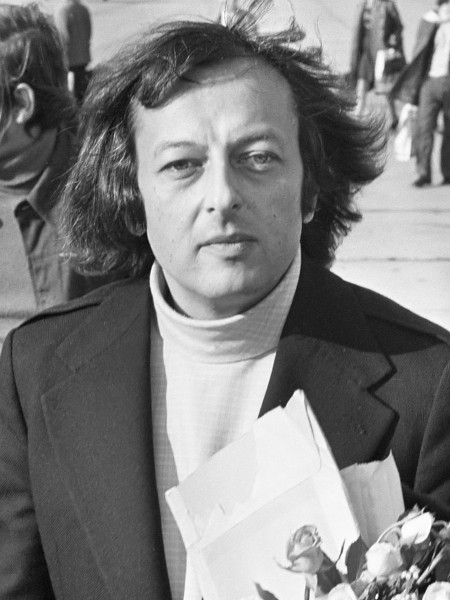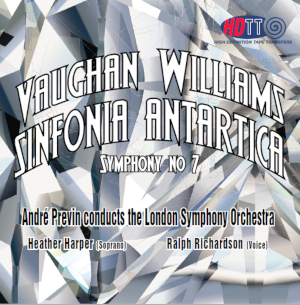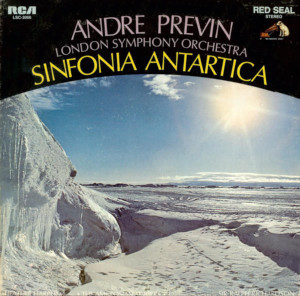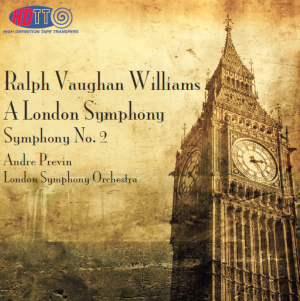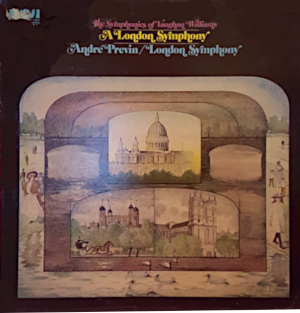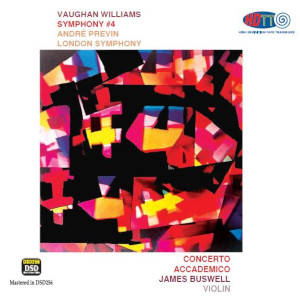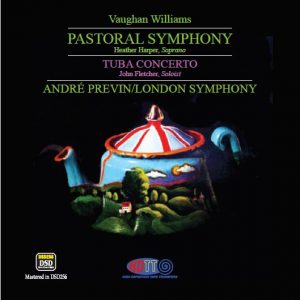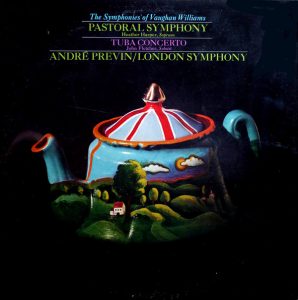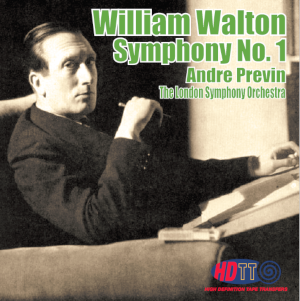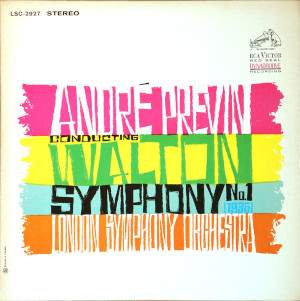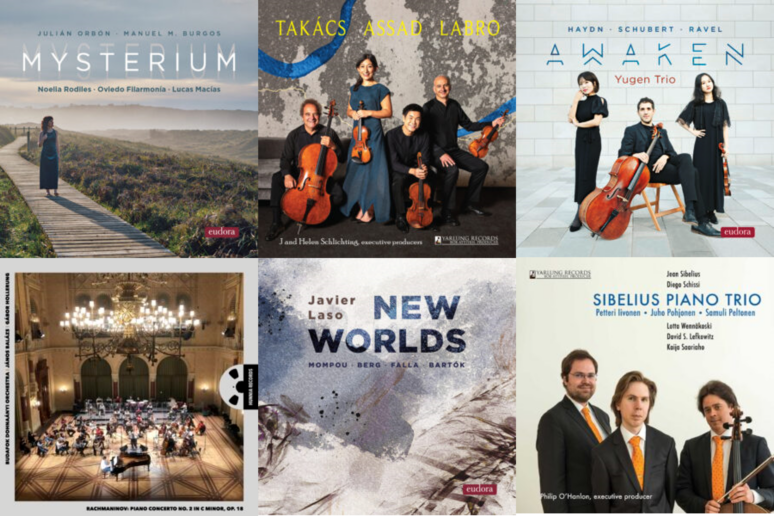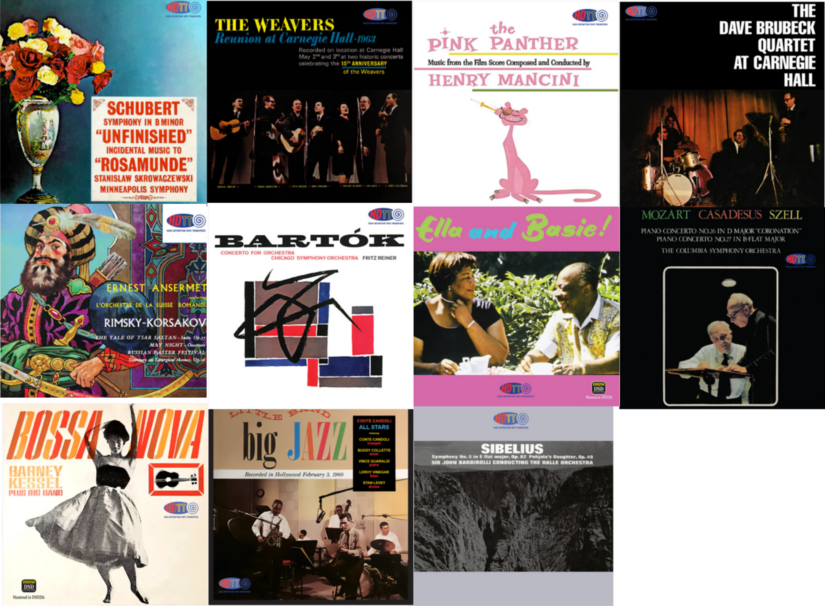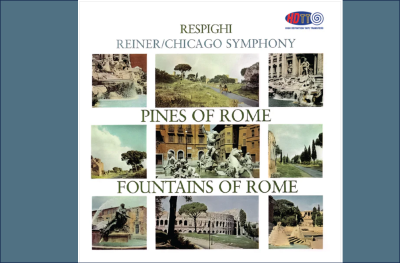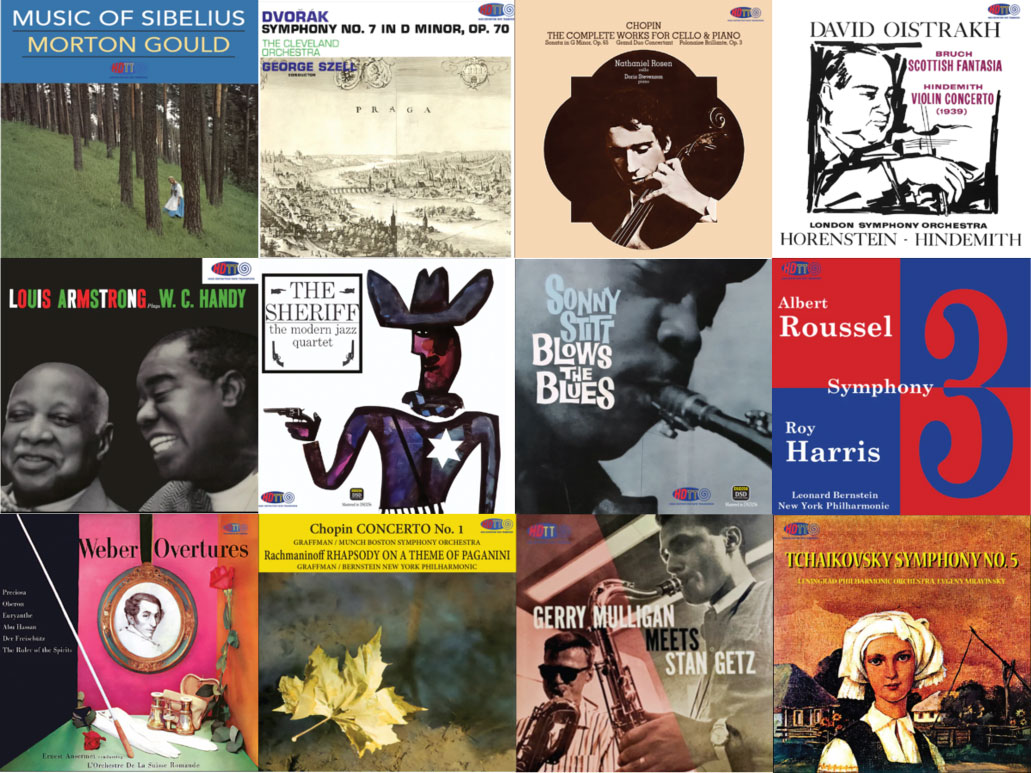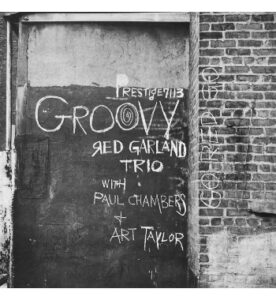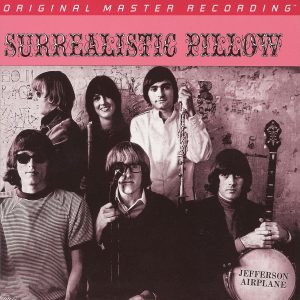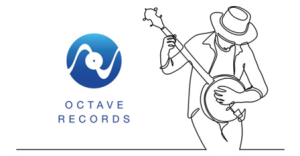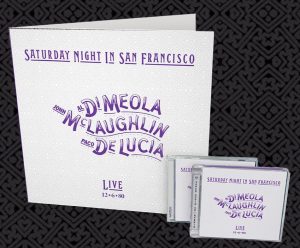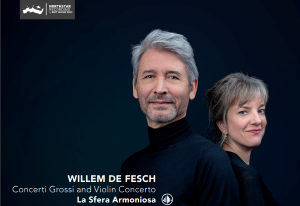Circa 1967, that is… Imprints on music are lifelong influences. Among my early imprints that I continue to cherish are the recordings made by André Previn with the London Symphony early in his career. Released by RCA from around 1967 to 1972, these Decca recorded performances are a consistent pleasure. The various Decca recording teams, principally Kenneth Wilkinson, gave the performances by Previn and the LSO a full, rich, detailed sonic treatment that are among the best of the Decca recordings.
And Previn reciprocated the courtesy by delivering performances that are insightful, fresh, and engaging. His performances of the music of Sir William Walton and Ralph Vaughan Williams continue to be standards by which later performances by other artists can be gauged.
Previn in October 1973. Photo by Bert Verhoeff - Creative Commons
At the time of these performances, Previn was known in the U.S. as the Hollywood film score arranger and composer whom few in the classical music world took very seriously. RCA took quite a commercial chance contracting these recordings. It didn't matter that Previn's work for Metro-Goldwyn-Mayer in the music of more than fifty films won four Academy Awards, the classical world can be a snooty bunch. And I fell right into that mindset—until I heard his 1967 recording of the Vaughan Williams' Symphony No. 7, Sinfonia Antarctica.
This was 1970, and I was madly dubbing any classical LPs I could find in preparation for heading off to my first year at university. I'd purchased a Teac reel-to-reel and a pile of blank tape with which I hoped to maintain my sanity during expected long hours of study in the dorm. A friend had this record in his family's collection, so we put it on and cranked up the Teac reel-to-reel to make a dub. And can you just imagine this "u-turn" in my head? Oh, yes, I was hooked. And I searched out more of Previn's recordings for RCA and gradually replaced my dubs with the LPs.
Today, both that Teac recorder and my Vaughan Williams LPs are long gone. But, I've been re-discovering these wonderful performances within High Definition Tape Transfer's catalog of vintage recordings as transferred by Bob Witrak to high quality digital downloadable files.
In a previous article, I talked about a number of recordings engineered by Decca legend Kenneth Wilkinson found in HDTT's catalogue. Here I'd like to share with you several more of Wilkinson's recordings, this time focused on André Previn's cycle of the Vaughan Williams' symphonies, one of the most acclaimed recorded cycles of these works.
All of these performances deserve to be reissued in even better quality sound, but these are the best I've been able to find in the here and now. (Perhaps the RCA box set of CDs issued in 2016? I don't know, I've not heard those CDs except in the MP3 samples online, but I doubt it.) So, I look at this article as a discussion of great musical performances by Previn and the LSO. I can hear Ann gasping now: You're talking about music first, not sound first?!? In this case, guilty as charged. I've loved these recordings for 50 years. And, in my defense, they were engineered by Wilkinson, after all.
Vaughan Williams: Symphony No. 7, Sinfonia Antartica, André Previn, London Symphony Orchestra, HDTT. (1967 RCA (24-192 transfer from LP) (NLA)
Yes, you read this correctly—this is a transfer from an LP using Bob's VPI Classic Turntable with Benz Wood Cartridge and an Emotive Audio Custom Phone pre-amp. Sounds pretty friggin' good, too. No observable surface noise, tremendous bass, good resolution and detail. I'm very happy to have this back in my collection. It's as though I've come full circle from my college years' dub, but in much better sound than I was able to achieve at that time.
This is André Previn starting his recording venture with RCA conducting music original written as a film score. What irony. The music of Sinfonia Antartica was first composed by Vaughan Williams for the film Scott of the Antarctic in 1947. Vaughan Williams later developed the film score into the symphony we have today.
Robert Falcon Scott (d. 1912) led a doomed expedition attempting to become the first to reach the South Pole. The expedition ended disastrously, with the entire group dying a mere eleven miles from their goal. Months after the expedition succumbed to the fierce cold, a search party discovered the tent and the bodies. Scott's diary was also recovered, allowing us to learn of the expedition's fate.
Original US RCA cover circa 1969.
The score includes a brief literary quotation preceding each movement, although Vaughan Williams made no directive to either include or exclude these texts. Performances that have included the spoken text include Sir Adrian Boult's first recording for Decca with Sir John Gielgud in 1954 and this 1971 recording by Previn for RCA with Sir Ralph Richardson. Given the use of spoken text preceding the movements, a particular challenge is presented by Vaughan William's directive that the last two movements not be interrupted, that the third progress without break into the fourth.
Previn solves this dilemma with great emotional impact by sustaining the final notes of the third movement as Scott's final journal entry is read by Richardson, ensuring no interruption to the music. The dramatic effect is notable. The chilling, horrific grandeur of the third movement is held over into the bittersweet intermezzo of the closing movement. Beautifully done, and precisely in accordance with Vaughan William's instructions.
I enjoy this symphony both with and without the spoken text. Here it is delivered with great effect, adding depth and meaning to the performance.
Vaughan Williams: Symphony No. 2, A London Symphony, André Previn, London Symphony Orchestra, HDTT. (1971 RCA (24-192 transfer from a RCA 4-track tape) (NLA)
In Vaughan Williams’ A London Symphony one finds a virtuosic, impressionistic work on a grand scale. In this 1971 performance, André Previn and the London Symphony deliver the work to us in perfect form. And the recording is another Kenneth Wilkinson wonder from Kingsway Hall.
Vaughan Williams revised the work numerous times since the original score of 1914 (available in a very nice recording by Richard Hickox on Chandos). What we hear in this recording is the final 1936 published score. The music is full of vitality and there is no question of the 1914 version supplanting it in my affections.
Original US RCA cover, circa 1971.
A London Symphony is perhaps my favorite among all the VW symphonies, and this performance/recording is my favorite among those I've heard. First, the LSO perform supremely well, displaying power and finesse in equal measure. Second, the phrasing, tempi, and dynamics chosen by Previn create alternating delicacy, tension, grandeur, sweetness, scale, and beauty all as called for by this wonderful music. Third, sound is excellent: full, resonant, dynamic, and richly wide-ranging—Wilkinson at his inestimable best.
Just find a copy of this recording and listen to it. Highly recommended—I just wish someday to find a transfer from a high quality source in full DXD or DSD256, as in the next two releases from HDTT.
Vaughan Williams: Symphony No. 4; Concerto Accademico, André Previn, London Symphony Orchestra, HDTT. (1969 RCA (Pure DSD256 transfer from a 15ips 2-track tape) (NLA)
Okay, I have to say this first: the sound quality of this transfer is exceptionally good! This is a great HDTT transfer direct in Pure DSD256, no post processing in PCM. The sound is open, pure, dynamic, and all one could hope for in a facsimile of the 15ips tape from which it comes, just as with other HDTT Pure DSD256 transfers. (Sorry, Ann, I just couldn't contain myself in delivering this nod first for the sound.)
The Concerto Accademico for Violin and Strings is the heart of this album for me. The Symphony No. 4 is very fine, but it is the former work to which I return again and again on this album. Not as beautifully lyrical as The Lark Ascending, this is a more lean and muscular work. Set in three movements, with the lively outer panels framing a subtle serene Adagio, there is little question about the folk song roots from which Vaughan Williams so frequently draws. American violinist James Oliver Buswell gives us a very nice performance from early in his career.
"I don't know whether I like it, but it's what I meant," Vaughan Williams is quoted as commenting about his Symphony No. 4, which was sketched out over the years 1931 and 1932, completed in 1934, and first performed in London on April 10, 1935, by the BBC Symphony Orchestra under Sir Adrian Boult. The dissonance and power of the Symphony No. 4 were not new elements in Vaughan Williams' music. Some of the same can be heard, for instance, in the ballet Job (1930), itself a masterful composition.
The symphony begins with a full onslaught by the orchestra in an imperious theme that frequently recurs in the work. The tone is one of anger and aggression. Even the more restrained second theme has a pulsating energy lurking beneath it, and the movement's occasional moments of humor are acid tinged. Some commentators see in this work Vaughan Williams' antipathy for the evolving events that would culminate in World War II. The composer's widow saw the symphony as autobiographical, a reflection of her husband's character: "The towering furies of which he was capable, his fire, pride, and strength are all revealed and so are his imagination and lyricism."
One can understand Vaughan Williams' ambivalence about whether he liked the work. It is not likeable in the congenial manner of his London Symphony, for example. But it is powerful; it does have something to tell us. Unlike Vaughan Williams, I do like the 4th but I find some of his other compositions more likeable.
Vaughan Williams: Pastoral Symphony (No. 3), Tuba Concerto, André Previn, London Symphony Orchestra, HDTT. (1969 RCA (Pure DSD256 transfer from a 15ips 2-track tape) (NLA)
In another superb transfer from HDTT we have two of Vaughan Williams more engaging orchestral compositions: his Pastoral Symphony and his not-to-be-overlooked Tuba Concerto. Really, tuba? Yes, really!
Do you read the liner notes when you listen to an album? I always have, and I think it's useful here to simply quote from the notes in this HDTT release because they are really quite interesting:
"Ralph Vaughan Williams' Symphony No. 3, published as A Pastoral Symphony and not numbered until later, was completed in 1922. Vaughan Williams' initial inspiration to write this symphony came during World War I, after hearing a bugler practicing and accidentally playing an interval of a seventh instead of an octave; this ultimately led to the trumpet cadenza in the second movement.
"The work is among the least performed of Vaughan Williams' symphonies, but it has gained the reputation of being a subtly beautiful elegy for the dead of World War I and a meditation on the sounds of peace. Like many of the composer's works, the Pastoral Symphony is not programmatic, but its spirit is very evocative. None of the movements are particularly fast or upbeat, but there are isolated extrovert sections to be found. It was first performed in London on 16 January 1922.
"The symphony was dismissed by Constant Lambert, who wrote that it was a 'creation of a particular type of grey, reflective, English-landscape mood has outweighed the exigencies of symphonic form'. (Peter Warlock's often-quoted comment, 'is all just a little too much like a cow looking over a gate', was in fact a comment on Vaughan Williams' style in general and was not aimed specifically at A Pastoral Symphony, which he on the contrary described as 'A truly splendid work' and 'the best English orchestral music of this century'.) Vaughan Williams emphasized, however, that the work had nothing to do with what he called 'lambkins frisking about' (i.e., English pastoral scenery); its reference is the fields of France during World War I, where the composer served in the Royal Army Medical Corps."
Original RCA cover, circa 1969. Most unusually reproduced largely intact by HDTT in their release.
I find in A Pastoral Symphony some of Vaughan Williams' most beautifully reflective and lyrical passages. Highly creative, deeply expressive, calming but with a dark melancholic undertone, this is a beautiful work of music. It is far more complex than a superficial listen leads one to understand, it is worthy of repeated listening to begin fathoming what Vaughan Williams has crafted. No, it is not that epic masterpiece that is his Sea Symphony (and to which Previn and the London Symphony Orchestra and Chorus give an idiomatically spirited and colorful performance); but it is most compelling in its own right.
As John Puccio writes about this Pastoral Symphony performance, "Previn and the LSO bring out all the beauty and restrained power of the work in a performance of grace and polish…This is not a big symphony in the conventional sense but music for quiet contemplation. As such, the Pastoral Symphony has never been among Vaughan Williams' most popular works…, but it is one of his loveliest and most thoughtful."
And now we come to the Tuba Concerto! I just love this work. How many times does one get to hear a concerto written for tuba?
More formally titled Concerto in F Minor for Bass Tuba and Orchestra, Vaughan Williams wrote this piece in 1954 for the principal tubist of the London Symphony Orchestra (LSO), Philip Catelinet, who gave the premiere in June 1954 with Sir John Barbirolli conducting. While at first viewed as the eccentric idea of an aging composer, the concerto soon became one of Vaughan Williams' most popular works, and an essential part of the tuba repertoire. (Wikipedia)
Lasting just 13 minutes, this is an engaging, smile generating, piece of bravura music.
Philip Catelinet writes an entertaining recollection of the whole affair, of which he says in part:
"(In 1952) I was offered work with both the London Symphony and Philharmonia Orchestra. Neither of these were contractual appointments, but both provided engagements based on program requirements. Not too satisfactory a situation, but at least it provided 'cash on the nail' and a fairly comfortable standard of living for myself and my family.
"Such was the situation when the news about "The Concerto" came to hand.
"I was at home. Maybe I was practicing! I really cannot recall what I was doing, but undoubtedly waiting on a telephone call. A job, perhaps? The telephone did ring. It was the secretary of the London Symphony Orchestra in a somewhat excited mood. Without preliminaries he stated: 'Ralph Vaughan Williams has written a tuba concerto and wants you to play it at our Jubilee Concert in June.' I'm not too sure whether the word 'want' was really a personal pronoun or maybe an implied 'we' representing the official orchestral management request.
"Whichever it was, I was quite terror stricken! As a musician, I really couldn't appreciate the idea of the tuba being the center attraction as soloist on a concerto at an orchestral concert. The tuba was too often connected by the public with what was humorous and ludicrous to be considered seriously a possibility on a concert platform.
"But, there was more to follow, making the premise a stern reality. The voice continued: 'Vaughan Williams wants you to call on him with your tuba at 3 o'clock and our resident pianist will arrive at the same time to play through the number with you!' "
And thus the beginnings for the Concerto in F Minor for Bass Tuba and Orchestra.
Today this work is one of the standards in the tuba repertoire. This performance by tubist John Fletcher is a proper credit to the piece. Displaying quite virtuosic musicianship, Fletcher's vibrant tone sings from the orchestra, easily accomplishing the extraordinary challenges presented by Vaughan Williams. "And Previn ensures that the three movements bounce (or galumph) along in good spirits." (Puccio)
The sound on this recording delivers to us what I have come to expect from a Kenneth Wilkinson recording: a warm, natural, realistic sound, with the orchestra presented in a natural acoustic space with all its breadth and depth. A perfect complement to the music.
William Walton: Symphony No. 1, André Previn, London Symphony Orchestra, HDTT. (1966 RCA (DSD128 transfer from a 15ips 2-track tape) (NLA)
This is a final treat for today... One of the earliest Previn recordings with the London Symphony Orchestra (the earliest?), and a performance that reverberated among classical music listeners on its release. This performance continues to be the standard by which other recordings of this symphony by English composer William Walton are measured.
Walton composed only two symphonies, and it is his Symphony No. 1 that continues as one of the best known symphonies by British composers. Walton had difficulty completing this work. The first public performance in 1934 was given without the final movement. The complete work premiered the following year in a performance by fellow composer and conductor Sir Hamilton Harty with the BBC Symphony Orchestra. The performance roused great enthusiasm. The News Chronicle reported at the time, "The applause at the close was overwhelming, and when Mr. Walton, a slim, shy, young man, came on to the platform he was cheered continuously for five minutes". Multiple international performances rapidly followed, with the Chicago Symphony Orchestra under Harty delivering the U.S. premier, followed by Eugene Ormandy and the Philadelphia Orchestra in the New York premier. (Wikipedia)
The work received its first recording just a month following the premier, and regular recordings have followed to this day. I see that Presto Classical currently lists over 30 CDs containing Walton's Symphony No. 1. Choices abound. Some are really good.
Walton wanted to blow his contemporaries out of the symphonic water with his First, writing "I may be able to manage to knock Bax off the map." (Arnold Bax had thus far written a handful of his symphonies to positive effect.) And, indeed, he must have done so. The Guardian writes in their Symphony Guide:
"This symphony is a volcanic eruption of dark, sensual passion which speaks with unmediated power from the very first bar. The first movement is one of the most unrelentingly intense experiences and most remarkable structures in 20th century music; the scherzo is a bitingly bitter Presto 'con malizia' ('with malice'); the slow movement is a melancholic ache of chromatic pain; and the fourth movement is the work’s major-key apotheosis, a controversially (even unsatisfyingly, for some) upbeat finale that sings, fugues, and shouts with joy."
You may gather that I like this symphony. Oh, yes. Indeed I do. When I first heard this music in the early 1970s in Previn's 1966 recording (released 1967), the music with its shattering climaxes made an impact on me, and it continues to do so each time I listen. It is music of savage, dark, emotional intensity, with a brilliantly celebratory and triumphant conclusion. People react differently to Walton's conclusion to this work, some finding it perhaps too overly emphatic, as if Walton's enthusiasm got the best of him. Well, after all the darkness and uncertainty expressed in the music that precedes it, I'm among those who like this finale very much indeed. Rousing! Soaring! Thrilling! Tympani pounding, tam tam splashing–yes! Nice to have an emphatic conclusion.
Original RCA cover, circa 1967
So why does Previn's performance continue to be my favorite given all the alternatives out there? Hmmm, it's really, really good! Previn and the LSO just nail it. Some will say that there is no finer orchestra than the LSO in the 1960's, and Andre Previn had their total devotion. Plus, here we have Kenneth Wilkinson and Kingsway Hall providing the fairy dust that makes this recording magic.
Previn re-recorded this work with the Royal Philharmonic Orchestra for Telarc in 1987, but this latter performance just doesn't have the verve and intensity of the original with the LSO from 20 years earlier. The Japanese CD re-release from 2007 of the 1966 recording sells for large dollars. Used LPs sell for cheap money on Discogs and elsewhere. I think this DSD128 transfer from HDTT is a bargain and sounds superb. But, however you can get this recording, just do it. You won't be disappointed.
Do I need to say it? Highly recommended.
Concluding thoughts about these Previn recordings for RCA… I think these performances by André Previn and the London Symphony Orchestra are some of the most musically engaging presentations of Vaughan Williams' works available. Yes, there are other performances I value, but these continue to be my standard of musical excellence, continuing to hold their own after 50 years.
Highly recommended just as they are from HDTT, even the Sinfonia Antartica transfer from LP.
A further note on the sound quality: The sound quality on files listed as Pure DSD256 transfers is excellent (Symphony No. 4 and Pastoral Symphony titles); clearly good source tape and excellent transfer. These rank with the best of the files I've heard from HDTT. The sound quality on the others is fine, but not to this higher standard; so one can hope someday for better a source tape and a new transfer. But, get these for the music! I don't know where one might be able to find better sonics in digital than are available in these transfers from HDTT.
My only wish? That Bob Witrak be able to locate 15ips tapes for the remainder of the Previn series with the LSO. And if we could get them in the sound quality that we hear in the Pure DSD256 transfers, that would be the cherry on the top. For now, I'm enjoying these very much.




